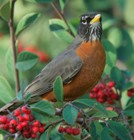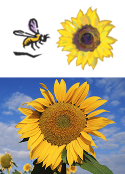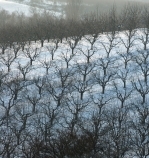Greetings!
The USA National Phenology Network has grown by leaps and bounds over the past year. In 2009, our staff of six at the National Coordinating Office worked with over 30 partner organizations and gave over 100 presentations at professional meetings. Our cadre of 900 observers, including 200 members of the historic lilac network, contributed 160,000 phenological observations on 215 species of plants to the National Phenology Database.
Later this year, we will release our new animal monitoring program, along with basic data visualizations and a more efficient online registration process. We couldn't be successful without great partnerships and we're grateful for your continued interest and support!
|
Next up: Animal Phenology
 Animals have phenology too and this spring the USA-NPN releases its national animal monitoring program. We will be tracking the arrival of
American robins, those sentinels of spring, as well as the calling of wood frogs, the appearance of spring azure butterflies, the spawning of American shad, the breeding of
white-tailed deer, and the egg laying of painted turtles, to name a few.
Animals have phenology too and this spring the USA-NPN releases its national animal monitoring program. We will be tracking the arrival of
American robins, those sentinels of spring, as well as the calling of wood frogs, the appearance of spring azure butterflies, the spawning of American shad, the breeding of
white-tailed deer, and the egg laying of painted turtles, to name a few.
Are these animals still
seasonally matched with the plants that they use for food and habitat? Are they active
earlier or later in the season? How are they handling environmental variation and change?
Learn more about our new animal phenology program and participate this spring!
|
Database & Interfaces
A key part of our mission is to create, store, document, track and share phenology data.  In spring 2009, we released an online national plant monitoring program, with a database and several online interfaces. This year, we adapted our system for animal monitoring, created basic data visualizations, and made many improvements to our website. We also created a beta data set registry tool to enable researchers and data curators to easily document and point to phenology data sets. We are planning enhancements to our interfaces for current and legacy data entry and developing high quality, interactive data visualization tools. |
Featured Partner: The Great Sunflowe r Project r Project
Last year, the USA-NPN partnered with the Great Sunflower Project, much to the benefit of both organizations. Great Sunflower Project participants plant sunflowers and then record bee visitation rates to provide scientists with data on bee abundance.
While they wait for the flowers to bloom and the bees to arrive, participants also observe the plant's phenology. Over 300 Great Sunflower Project members contributed data to the USA-NPN in 2009. The collaboration continues this year, with ever growing numbers of participants.
There are many ways to collaborate with the USA-NPN - email us to find out more.
|
Winter to Spring
 Although winter
isn't typically thought of as an active time in plant and animal life cycles, the cold months are critical for orchards. Many tree
species have irregular bloom
and fruit times without a long enough cold period, wreaking havoc on the fruit and nut industries (read more on our website). Although winter
isn't typically thought of as an active time in plant and animal life cycles, the cold months are critical for orchards. Many tree
species have irregular bloom
and fruit times without a long enough cold period, wreaking havoc on the fruit and nut industries (read more on our website). 
Earlier springs are following on the heels of warmer winters, and the changes in spring phenology seen in New England are beautifully documented in Amy Seidl's new book Early Spring.
|
|